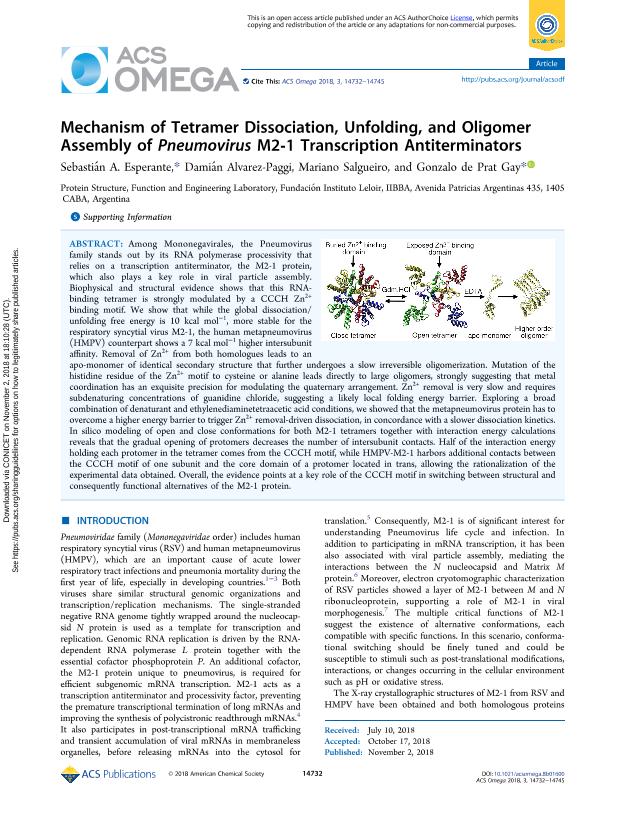Mostrar el registro sencillo del ítem
dc.contributor.author
Esperante, Sebastian

dc.contributor.author
Álvarez Paggi, Damián Jorge

dc.contributor.author
Salgueiro, Mariano

dc.contributor.author
de Prat Gay, Gonzalo

dc.date.available
2019-11-28T22:52:18Z
dc.date.issued
2018-11
dc.identifier.citation
Esperante, Sebastian; Álvarez Paggi, Damián Jorge; Salgueiro, Mariano; de Prat Gay, Gonzalo; Mechanism of Tetramer Dissociation, Unfolding, and Oligomer Assembly of Pneumovirus M2-1 Transcription Antiterminators; American Chemical Society; ACS Omega; 3; 11; 11-2018; 14732-14745
dc.identifier.issn
2470-1343
dc.identifier.uri
http://hdl.handle.net/11336/90866
dc.description.abstract
Among Mononegavirales, the Pneumovirus family stands out by its RNA polymerase processivity that relies on a transcription antiterminator, the M2-1 protein, which also plays a key role in viral particle assembly. Biophysical and structural evidence shows that this RNA-binding tetramer is strongly modulated by a CCCH Zn2+ binding motif. We show that while the global dissociation/unfolding free energy is 10 kcal mol-1, more stable for the respiratory syncytial virus M2-1, the human metapneumovirus (HMPV) counterpart shows a 7 kcal mol-1 higher intersubunit affinity. Removal of Zn2+ from both homologues leads to an apo-monomer of identical secondary structure that further undergoes a slow irreversible oligomerization. Mutation of the histidine residue of the Zn2+ motif to cysteine or alanine leads directly to large oligomers, strongly suggesting that metal coordination has an exquisite precision for modulating the quaternary arrangement. Zn2+ removal is very slow and requires subdenaturing concentrations of guanidine chloride, suggesting a likely local folding energy barrier. Exploring a broad combination of denaturant and ethylenediaminetetraacetic acid conditions, we showed that the metapneumovirus protein has to overcome a higher energy barrier to trigger Zn2+ removal-driven dissociation, in concordance with a slower dissociation kinetics. In silico modeling of open and close conformations for both M2-1 tetramers together with interaction energy calculations reveals that the gradual opening of protomers decreases the number of intersubunit contacts. Half of the interaction energy holding each protomer in the tetramer comes from the CCCH motif, while HMPV-M2-1 harbors additional contacts between the CCCH motif of one subunit and the core domain of a protomer located in trans, allowing the rationalization of the experimental data obtained. Overall, the evidence points at a key role of the CCCH motif in switching between structural and consequently functional alternatives of the M2-1 protein.
dc.format
application/pdf
dc.language.iso
eng
dc.publisher
American Chemical Society

dc.rights
info:eu-repo/semantics/openAccess
dc.rights.uri
https://creativecommons.org/licenses/by-nc-sa/2.5/ar/
dc.subject
antiterminador
dc.subject
pneumovirus
dc.subject
oligomerizacion
dc.subject
proteina
dc.subject.classification
Bioquímica y Biología Molecular

dc.subject.classification
Ciencias Biológicas

dc.subject.classification
CIENCIAS NATURALES Y EXACTAS

dc.title
Mechanism of Tetramer Dissociation, Unfolding, and Oligomer Assembly of Pneumovirus M2-1 Transcription Antiterminators
dc.type
info:eu-repo/semantics/article
dc.type
info:ar-repo/semantics/artículo
dc.type
info:eu-repo/semantics/publishedVersion
dc.date.updated
2019-10-22T17:38:19Z
dc.journal.volume
3
dc.journal.number
11
dc.journal.pagination
14732-14745
dc.journal.pais
Estados Unidos

dc.description.fil
Fil: Esperante, Sebastian. Consejo Nacional de Investigaciones Científicas y Técnicas. Oficina de Coordinación Administrativa Parque Centenario. Instituto de Investigaciones Bioquímicas de Buenos Aires. Fundación Instituto Leloir. Instituto de Investigaciones Bioquímicas de Buenos Aires; Argentina
dc.description.fil
Fil: Álvarez Paggi, Damián Jorge. Consejo Nacional de Investigaciones Científicas y Técnicas. Oficina de Coordinación Administrativa Parque Centenario. Instituto de Investigaciones Bioquímicas de Buenos Aires. Fundación Instituto Leloir. Instituto de Investigaciones Bioquímicas de Buenos Aires; Argentina
dc.description.fil
Fil: Salgueiro, Mariano. Consejo Nacional de Investigaciones Científicas y Técnicas. Oficina de Coordinación Administrativa Parque Centenario. Instituto de Investigaciones Bioquímicas de Buenos Aires. Fundación Instituto Leloir. Instituto de Investigaciones Bioquímicas de Buenos Aires; Argentina
dc.description.fil
Fil: de Prat Gay, Gonzalo. Consejo Nacional de Investigaciones Científicas y Técnicas. Oficina de Coordinación Administrativa Parque Centenario. Instituto de Investigaciones Bioquímicas de Buenos Aires. Fundación Instituto Leloir. Instituto de Investigaciones Bioquímicas de Buenos Aires; Argentina
dc.journal.title
ACS Omega
dc.relation.alternativeid
info:eu-repo/semantics/altIdentifier/doi/http://dx.doi.org/10.1021/acsomega.8b01600
dc.relation.alternativeid
info:eu-repo/semantics/altIdentifier/url/https://pubs.acs.org/doi/10.1021/acsomega.8b01600
Archivos asociados
